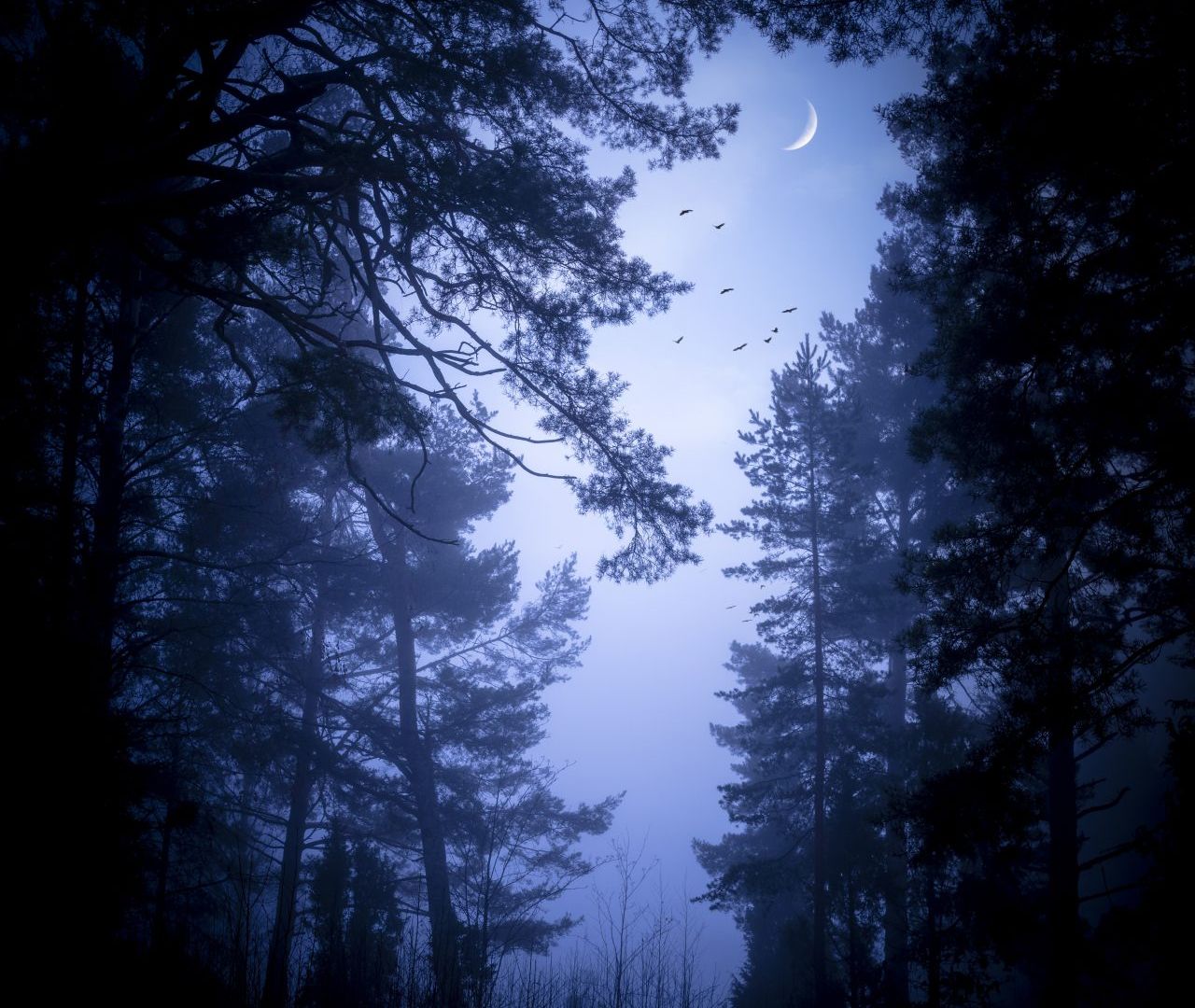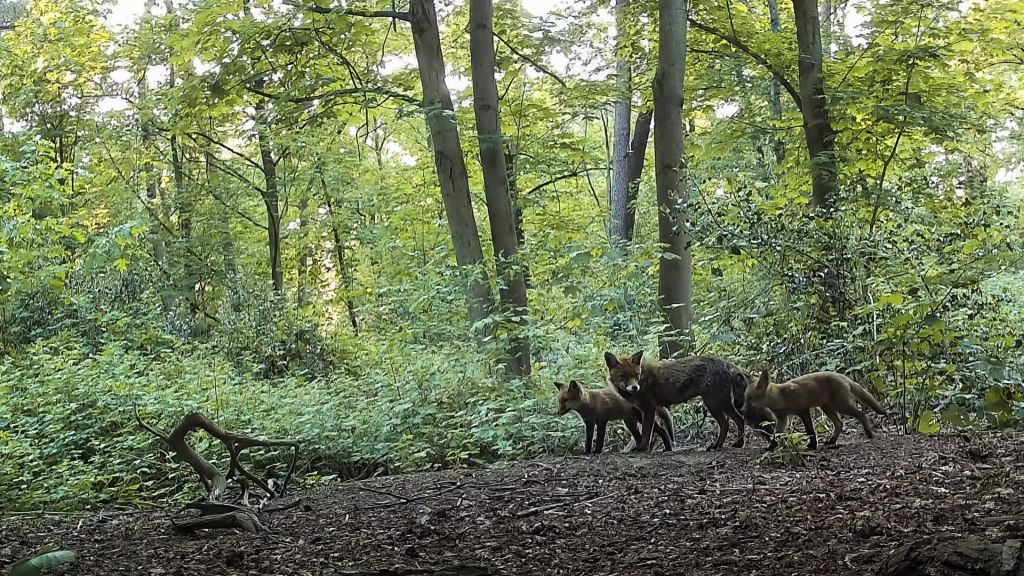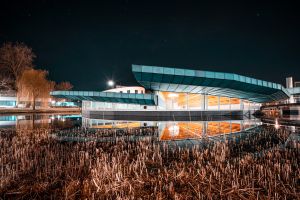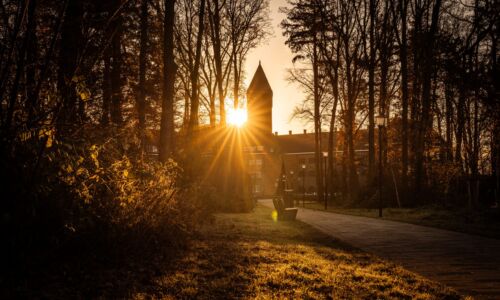After dusk, bats, foxes and other nocturnal animals are taking over the campus
-
 Foto: GettyImages
Foto: GettyImages
As soon as the sun has set, all kinds of animals appear on campus. Foxes have been recorded, and a peregrine falcon is hatching their egg as well. You can even observe glowworms in the Hortus, a special case for Nijmegen.
You rarely see them, but there are aplenty: bats. Common pipistrelles, common noctules, serotine bats, Nathusius’ pipistrelles, Daubenton’s bats, and brown long-eared bats were spotted during a night excursion at the Berchmanianum.
The bats on campus have been monitored so well because they are protected animals that need to be considered during construction work. You have to assess if they are living in a building before you bring in a bulldozer, and if they do, help re-home them.
‘It is entirely possible that deer walk around the campus’
‘We have placed flat black boxes at different spots on campus, for example against the trees around the Berchmanianum,’ says Guido van Gemert, environmental advisor for the Radboudumc. ‘Then you need to give the bats a couple months to settle there.’
Traces
It’s uncertain which other animals are active on campus at night; there aren’t cameras everywhere to capture every square metre of darkness. A camera is only installed every once in a while, for example during the extensive renovation of the Radboudumc. A fox den was caught on camera. It turned out that the den was not in use anymore, but a few weeks later, the camera did register a fox – and a beech marten. Earlier, a night camera had caught five young foxes on campus as part of the Natuurgluren project.
Van Gemert says that traces of a European badger have also been found, but the animal itself has never been detected. ‘It is entirely possible that deer walk around the campus sometimes – they do live nearby – but they have never been spotted.’ There are also hedgehog houses placed on campus, but it is not clear if they are in use. ‘We never put a camera there.’
Has a wolf ever set foot on campus grounds? ‘Unlikely, but you never know. A wolf did walk on the embankment in Lent last year.’ Julia Schepers, land animal specialist of the Zoogdiervereniging, doesn’t think so, however. ‘Wolves usually try to move through agricultural enclaves and natural areas as much as possible and avoid the city. If one would pass through here, it would be a one-time thing; a wolf would never settle on campus.’
Programme manager of biodiversity Margot Jansen says that the peregrine falcon does certainly appear on campus. It was spotted by a camera near a nesting box on top of the Erasmus building. A 2022 report by Bureau Stroming about the biodiversity of the Radboud University and Radboudumc campus also mentions rabbits, brown hares, brown owls, hedgehogs, mice, cats, rats, spiders, and the alpine newt.
What’s a nocturnal animal?
It seems like an easy question, but it is not, says professor of animal ecology Henk Siepel. ‘We don’t really talk about night-animals, but about night-active animals. But it is often quite clear; for example, owls – with the exception of the little owl and the short-eared owl – are nocturnal animals, bats too.’
‘Moths are most often active at night to avoid predators. That is exactly why bats are nocturnal and why a lot of moths have some kind of stealth coat – it is invisible to the bat’s sonar.’
Some animals also prefer the night because it is too busy and turbulent during the day. Siepel: ‘Think for example of foxes or wild boars. If the area is quieter – or if more food needs to be collected – then those animals are also active during the day.’
Julia Schepers from the Zoogdiervereniging agrees with Siepel. ‘There are a lot of diurnal animals who get dispersed to the night because there is too much human activity during the day. If no people were to walk here, you would be able to spot a fox on campus during the day; they have a lot of territory. More animals were seen in the city during the corona crisis because it was quieter on the streets.’
Animal-friendly campus
The university and the Radboudumc are as considerate as possible with the animals that do live here. For example, the lanterns on the side of the walking paths shine down, not up, and the light is dimmed. That is an adjustment for the bats.
‘Ideally, the lights would be put out entirely, but that might not be feasible for social safety reasons,’ says Erik Broer, bat specialist at the Zoogdiervereniging. ‘However, you could think of other solutions, such as motion sensors or different coloured lights for animals who are sensitive to it.’ Bats become active at twilight. ‘They forage after sundown and before sunrise. Bats get closer to humans because they live in buildings.’
The university would like to eventually know more about which animals move around in the dark. ‘We would like to develop a structured monitoring system, also for nocturnal animals. By creating shaded areas and wadis, we improve the circumstances for animals to come to campus,’ Van Gemert says. ‘We are planting more and more shrubs and trees that carry fruit. Then you have to keep track if that’s successful.’
Hortus
The east side of the campus is adjacent to Park Brakkenstein, where a number of employees take their lunch break strolls. Located there is Hortus Botanicus, or the botanical garden, which belongs to the top three natural gems of Nijmegen alongside two areas in the Waal’s floodplains. According to manager Bas Budel and board member Jan Jansen, it gets quieter and darker there at night, but not completely pitch black. ‘The university’s greenhouses and the lamps of the nearby tennis fields produce artificial light,’ says Budel.
The fact that there are not a lot of animals observed during the night is even more the case for the Hortus than for the campus, but Jansen speculates that all the animals that are active on campus, are also present at the Hortus. ‘We could learn more with wildlife cameras, but those are prone to vandalism and theft.’
There are no cameras needed for the common frog and common toad, as their croaks make their presence known. ‘The common frog treks to the pond at twilight or during the night to breed,’ Jansen explains. The male frogs croak at the start of spring to let the females know where they are located. ‘You can see and hear that by the waterfall at the Alpinum. The crepuscular and nocturnal alpine newt is also active there.’
‘The Hortus is a great place for food for sap-feeding insects’
The Hortus is also important for moths. 104 species have been counted, such as the hummingbird hawk-moth, the elephant hawk moth, and the lime hawk-moth. ‘That is because the garden houses a lot of wild plants, and their flowers are often very interesting for butterflies, moths, and other insects,’ says Jansen. ‘Because of that, it’s a great place for food for sap-feeding insects, like aphids, bugs, and cicadas.’
A special resident of the Hortus is the common glowworm. They can only be found in Nijmegen either in or around the botanical garden. The males have wings, the females will wave their glowing undersides and find an open spot in the grass, preferably on chalk soil, like in the south of the garden. ‘That’s how their chance of reproduction increases because the males can see their lights from tens of metres away,’ Jansen says. The females glow for two hours, mostly on evenings in June and July, and then retreat into their lairs until the next evening.
The biggest insect that has been observed in the Hortus is the European stag beetle. ‘If you are lucky, you can find them on summer evenings in June,’ says professor of animal ecology Henk Siepel. ‘The larvae live in old oak stumps and feed on mould. It takes them four to six years to develop into an adult beetle, depending on the food quality and temperature.’ There are some big oak stumps partially buried in the Hortus to make them appealing for the stag beetle. Languishing oaks are also left intact, so that as many animals as possible can find a natural breeding place.
Translated by Milou Aluy-van der Meij






